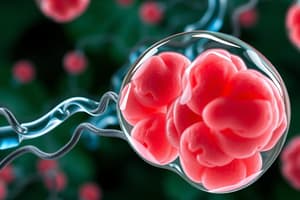Podcast
Questions and Answers
What is the primary function of hemoglobin in the human body?
What is the primary function of hemoglobin in the human body?
To bind with oxygen molecules inhaled from the lungs and release them to tissues where they're needed throughout the body.
Describe the structure of hemoglobin.
Describe the structure of hemoglobin.
Hemoglobin is made up of four polypeptide chains - two alpha chains and two beta chains, with each chain having around 141 amino acids.
What causes the bright cherry red color of oxygenated blood?
What causes the bright cherry red color of oxygenated blood?
Oxygen binds tightly to iron atoms in hemoglobin, forming oxyhemoglobin which gives blood its characteristic deep red hue.
Explain why deoxygenated blood appears darker red or even purple in color.
Explain why deoxygenated blood appears darker red or even purple in color.
How does the availability of oxygen influence the color of blood?
How does the availability of oxygen influence the color of blood?
Study Notes
Human Blood Color: Understanding Hemoglobin's Influence
Hemoglobin, the protein responsible for oxygen transport within our bodies, plays a crucial role in determining human blood color. This protein is found inside red blood cells and is made up of four polypeptide chains - two alpha chains and two beta chains. Each chain has around 141 amino acids, making the entire molecule quite large with a molecular weight of approximately 68 kilodaltons.
The primary function of hemoglobin is to bind with oxygen molecules inhaled from the lungs and release them to tissues where they're needed throughout the body. Without this process, the body would struggle to survive, as there wouldn't be enough oxygen available to sustain life. The availability of oxygen influences the color of blood:
- When blood is fully saturated with oxygen, it appears bright cherry red due to the presence of oxyhemoglobin. Oxygen binds tightly to iron atoms in the protein, giving blood its characteristic deep red hue.
However, when blood is deoxygenated - for example, after being removed from the body - it loses some of its vibrancy and takes on more of a darker red or even purple appearance. This happens because the oxygen dissociates from the iron atoms, leaving behind a less saturated version called deoxyhemoglobin.
In summary, the color of human blood is largely dictated by the presence of different forms of hemoglobin: oxygenated (oxyhemoglobin) and deoxygenated (deoxyhemoglobin). These forms vary depending on the amount of oxygen in the blood, which itself varies depending on factors such as respiration rate and location within the circulatory system.
Studying That Suits You
Use AI to generate personalized quizzes and flashcards to suit your learning preferences.
Description
Explore the influence of hemoglobin on human blood color, from the role of this protein in oxygen transport to the impact of oxygenation levels on blood appearance. Learn about oxyhemoglobin and deoxyhemoglobin and how they determine the bright cherry red or dark red/purple hue of blood.




